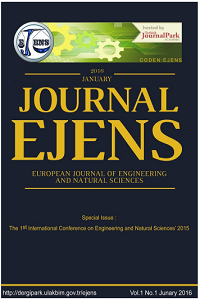An Investigation of Intelligent and Conventional Maximum Power Point Tracking Techniques for Uniform Atmospheric Conditions
An Investigation of Intelligent and Conventional Maximum Power Point Tracking Techniques for Uniform Atmospheric Conditions
PV Model, Maximum Power Point Tracking, Perturb & Observe Incremental Conductance, Fuzzy Logic Control, Neural Network Control,
___
- [1]. J. Ahmed and Z. Salam, “A Modified P&O Maximum Power Point Tracking Method With Reduced Steady-State Oscillation and Improved Tracking Efficiency,” IEEE Trans. Sustain. Energy, vol. 7, no. 4, pp. 1506–1515, Oct. 2016.
- [2]. A. B. . Bahgat, N. . Helwa, G. . Ahamd, and E. . El Shenawy, “Estimation of the maximum power and normal operating power of a photovoltaic module by neural networks,” 2004.
- [3]. J.-K. Shiau, Y.-C. Wei, and B.-C. Chen, “A Study on the Fuzzy-Logic-Based Solar Power MPPT Algorithms Using Different Fuzzy Input Variables,” Algorithms, vol. 8, no. 2, pp. 100–127, Apr. 2015.
- [4]. P. Takun, S. Kaitwanidvilai, and C. Jettanasen, “Maximum Power Point Tracking using Fuzzy Logic Control for Photovoltaic Systems,” in Proceedings of the International MultiConference of Engineers and Computer Scientists, 2011.
- [5]. A. Gupta, Y. K. Chauhan, and R. K. Pachauri, “A comparative investigation of maximum power point tracking methods for solar PV system,” Sol. Energy, vol. 136, pp. 236–253, 2016.
- [6]. E. Kandemir, N. S. Cetin, and S. Borekci, “A comprehensive overview of maximum power extraction methods for PV systems,” Renew. Sustain. Energy Rev., vol. 78, pp. 93–112, 2017.
- [7]. S. Saravanan and N. Ramesh Babu, “Maximum power point tracking algorithms for photovoltaic system – A review,” Renew. Sustain. Energy Rev., vol. 57, pp. 192–204, 2016.
- [8]. M. A. G. de Brito, L. Galotto, L. P. Sampaio, G. de A. e Melo, and C. A. Canesin, “Evaluation of the Main MPPT Techniques for Photovoltaic Applications,” IEEE Trans. Ind. Electron., vol. 60, no. 3, pp. 1156–1167, Mar. 2013.
- [9]. K. Karabacak and N. Cetin, “Artificial neural networks for controlling wind–PV power systems: A review,” Renew. Sustain. Energy Rev., vol. 29, pp. 804–827, Jan. 2014.
- [10]. D. Gonzalez Montoya, C. A. Ramos Paja, and R. Giral, “Maximum power point tracking of photovoltaic systems based on the sliding mode control of the module admittance,” Electr. Power Syst. Res., vol. 136, pp. 125–134, 2016.
- [11]. E. Kandemir, N. S. Cetin, and S. Borekci, “A Comparison of Perturb & Observe and Fuzzy-Logic Based MPPT Methods for Uniform Environment Conditions,” Period. Eng. Nat. Sci., vol. 5, no. 1, pp. 16–23, 2017.
- [12]. A. R. Jordehi, “Maximum power point tracking in photovoltaic (PV) systems: A review of different approaches,” Renew. Sustain. Energy Rev., vol. 65, pp. 1127–1138, 2016.
- [13]. S. Borekci, E. Kandemir, and A. Kircay, “A Simpler Single-Phase Single-Stage Grid-Connected PV System with Maximum Power Point Tracking Controller,” Elektron. ir Elektrotechnika, vol. 21, no. 4, pp. 44–49, Aug. 2015.
- [14]. C. S. Chiu, “T-S Fuzzy Maximum Power Point Tracking Control of Solar Power Generation Systems,” IEEE Transactions on Energy Conversion, vol. 25, no. 4. pp. 1123–1132, 2010.
- [15]. L. L. Jiang, D. R. Nayanasiri, D. L. Maskell, and D. M. Vilathgamuwa, “A hybrid maximum power point tracking for partially shaded photovoltaic systems in the tropics,” Renew. Energy, vol. 76, pp. 53–65, 2015.
- Başlangıç: 2015
- Yayıncı: CNR Çevre
Toygun Dağdevir, Orhan Keklikcioglu, Veysel Ozceyhan
MATLAB GUI Model for PV System Feasibility of a House Electricity Consumption in Turkey
Kübra Nur Akpınar, Ayşe Ceyda BİLÜ, Bedri KEKEZOĞLU
Characteristics of Some Turkish Lignites and Potential of Using in Agricultural Sector
Ali Serkan SOYDAN, Arzu YAVAŞ, Osman Ozan AVİNÇ, Gizem Karakan GÜNAYDIN, M. Niyazi KIVILCIM, Mehmet DEMİRTAŞ, Sema Palamutcu
Ekrem KANDEMIR, Numan Sabit CETİN, Selim BOREKCİ
Solar Radiation Modeling with Adaptive Approach
Emre Akarslan, Fatih Onur Hocaoglu
A Useful Way to Dispose of Phenolic-rich Agro-industrial Wastes: Mushroom Cultivation
The effect of the consideration of slab dimensions on optimum design of reinforced concrete beams
Sinan Melih Nigdeli, Gebrail Bekdaş
Design of a Robotic Pneumatic Pruner for Robotic Apple Harvesting
